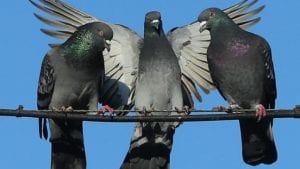
by Pigeon Patrol | Mar 16, 2020 | 4-S Gel Bird repellent, Animal Deterrent Products, Bird Deterrent Products, Bird Netting, Bird Spike, Bird Spikes, Pigeon Control, Pigeon Droppings, Pigeon Patrol's Services, Pigeon Spikes, Pigeons in the News, UltraSonic Bird Control
Pigeon Racing from japan flies across pacific to Canada
OTTAWA (AFP) – A plucky pigeon that flew across the Pacific Ocean from Japan will be bred by a bird lover in Canada hoping its progeny will be top long distance racers, an animal rescue official said Monday.
The pigeon was discovered tired and thin at a Canadian air force base on Vancouver Island in westernmost Canada and taken to an animal rescue centre near Comox, British Columbia where it was treated for a common bird parasite and nursed back to health.
“We believe it took off from land in Japan and got confused or got caught up in a storm and got lost before eventually hopskotching its way to Canada, stopping and sleeping on freighters along the way,” the Mountainaire Avian Rescue Society’s Reg Westcott told AFP.
A pigeon’s top range is typically 650 kilometers (404 miles). This one traveled 8,000 kilometers (4,971 miles).
The owner was contacted at a telephone number printed on a tag on the bird’s leg, but he did not wish to pay to have the pigeon flown back aboard a commercial jetliner, Westcott said.
The local Pigeon Racing Society offered to take in the wayward bird and set it up with some female birds. “I’m sure his offspring would be very good long range racers,” Westcott commented.
Canadian authorities, however, initially weren’t sure what could be done with the pigeon.
“They asked us whether he had travel documents and so on, and we said, ‘No, he flew here on his own,’ and so they labeled it a migratory bird, which allowed us to hand it over, without (having to fill out) a bunch of Customs paperwork, to the local pigeon racing society, which offered to give it a new home,” Westcott said.
In his 17 years caring for injured wildlife, Westcott said he has only come across one other pigeon that made the incredible two or three week voyage across the Pacific Ocean.
That one landed on a Canadian Coast Guard ship at the height of the avian influenza pandemic that saw millions of birds slaughtered to prevent the spread of the disease, and was eventually sent back to Japan at the owner’s expense, he said.
Westcott said he has also nursed a lost Brown Pelican from California, and a Citrine Wagtail songbird from Asia.
Birders from all over the United States and Canada flocked to Vancouver Island to get a rare glimpse of the Wagtail at the time, he said.
source
At Pigeon Patrol, we manufacture and offer a variety of bird deterrents, ranging from Ultra-flex Bird Spikes with UV protection, Bird Netting, 4-S Gel and the best Ultrasonic and audible sound devices on the market today.
Contact us at 1- 877– 4– NO-BIRD, (604) 585-9279 or visit our website at www.pigeonpatrol.ca
Bird Gone, Pigeon Gone, Seagull Gone, Pigeon issue, pigeon spikes, 1-877-4NO-BIRD, 4-S Gel, Bird Control, Pigeon Control, bird repellent, Bird Spikes, sonic bird repellent, stainless steel bird spikes, bird spikes Vancouver, Ultra Sonic Bird Control, Bird Netting, Plastic Bird Spikes, Canada bird spike deterrents, Pigeon Pests, B Gone Pigeon, Pigeon Patrol, pest controller, pest control operator, pest control technician, Pigeon Control Products, humane pigeon spikes, pigeon deterrents, pigeon traps, Pigeon repellents, Sound & Laser Deterrents, wildlife control, raccoon, skunk, squirrel deterrent, De-Fence Spikes, Dragons Den, Canada bird spikes, Canada pigeon, pigeon control, pigeon patrol, pigeon. Kill pigeons, crow, starling
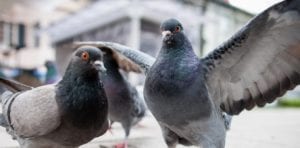
by Pigeon Patrol | Mar 4, 2020 | 4-S Gel Bird repellent, Animal Deterrent Products, Bird Deterrent Products, Bird Netting, Bird Spike, Bird Spikes, Pigeon Control, Pigeon Droppings, Pigeon Patrol's Services, Pigeon Spikes, Pigeons in the News, UltraSonic Bird Control
Why Aren’t Cities Littered With Dead Pigeons? Any fair-sized city in the United States is lousy with pigeons, hoovering up bread crumbs from public squares and head-bobbing so much they look like little Jay Zs groovin’ to some fresh beats. The favorite rumpus room of the pigeon, New York City, is thought to contain anywhere between 1 and 7 million of the flapping rats of the sky.
So where are the littered dead pigeons?
The short answer is in Pigeon Heaven (unless they’ve been bad birds, in which case they’re squawking in boiling pitch  in Pigeon Hell). The long answer is that the life of a pigeon is brutal and short, and if they do make it to the end zone without something terribly unpleasant happening they tend to want to die away from all the cameras.
in Pigeon Hell). The long answer is that the life of a pigeon is brutal and short, and if they do make it to the end zone without something terribly unpleasant happening they tend to want to die away from all the cameras.
In the interest of clearing up this enduring urban mystery, I contacted a couple of bird experts to expand on the ultimate fate of Columba livia. The first is David Seerveld, a licensed wildlife-control specialist (not exterminator! That’s for bug guys) in Orlando, Florida. In the course of his work, Seerveld has dealt with a full deck of frightened and sometimes frightening animals, including scads of pigeons that have slipped past our defenses to penetrate the human domain.
A pigeon that leads a pampered life might make it to age 15 before croaking. But most rarely live that long—five years in the wild is typical. America’s cities are patrolled by an invisible battalion of predators, all of whom seem to enjoy a meal of fat pigeon breast with a side of filoplumes. “Even with a huge level development like in Washington, D.C. or Chicago, these cities still have plenty of trees,” says Seerveld.
Source
At Pigeon Patrol, we manufacture and offer a variety of bird deterrents, ranging from Ultra-flex Bird Spikes with UV protection, Bird Netting, 4-S Gel and the best Ultrasonic and audible sound devices on the market today.
Contact us at 1- 877– 4– NO-BIRD, (604) 585-9279 or visit our website at www.pigeonpatrol.ca
Bird Gone, Pigeon Gone, Seagull Gone, Pigeon issue, pigeon spikes, 1-877-4NO-BIRD, 4-S Gel, Bird Control, Pigeon Control, bird repellent, Bird Spikes, sonic bird repellent, stainless steel bird spikes, bird spikes Vancouver, Ultra Sonic Bird Control, Bird Netting, Plastic Bird Spikes, Canada bird spike deterrents, Pigeon Pests, B Gone Pigeon, Pigeon Patrol, pest controller, pest control operator, pest control technician, Pigeon Control Products, humane pigeon spikes, pigeon deterrents, pigeon traps, Pigeon repellents, Sound & Laser Deterrents, wildlife control, raccoon, skunk, squirrel deterrent, De-Fence Spikes, Dragons Den, Canada bird spikes, Canada pigeon, pigeon control, pigeon patrol, pigeon. Kill pigeons, crow, starling
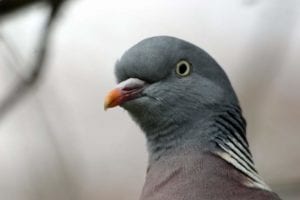
by Pigeon Patrol | Mar 4, 2020 | 4-S Gel Bird repellent, Animal Deterrent Products, Bird Deterrent Products, Bird Netting, Bird Spike, Bird Spikes, Pigeon Control, Pigeon Droppings, Pigeon Patrol's Services, Pigeon Spikes, Pigeons in the News, UltraSonic Bird Control
Pigeon’s vision in the dark? This question seems to spark very different answers from different flyers. Some will say yes, once dark trained or obviously they would fly into things, others differing in percentages of the pigeon’s vision once flying into the dark. In racing pigeons, great attention is paid to the eye as a means of choosing racers and producers. A pigeon with little eye-sign or lack of depth in the coloration would be a poor producer and almost certainly a moderate racer. Could we draw any conclusions to help us with Flying Tipplers into the dark? I have done the following tests:
Firstly, I took a pigeon from the loft, which was already dark-trained. I took him in daylight, in good weather conditions and out of distance of his usual flying patterns (about 5 miles) and released him. Within a short time he was back to the loft. I waited for dark and took the same bird to the same position and released him. He returned the next day in daylight. I did this three times with three different dark-trained Tipplers and not one could get back to the loft in the dark. Could we conclude from this the urge to return was present, only the ability to do so in the dark was lacking.
As we know, when a pigeon is flying in the dark he sticks to certain flying patterns. I released the same three birds individually along route of the bird’s fly pattern (about l ½ miles) from the loft. This time, all three birds made it back to the loft in the dark within a couple of minutes. I am now asking myself how much does the pigeon actually see in the dark and how much is he using his intimate local knowledge of the area built up from his many hours of dark training?
I am now trying out some more detailed tests, but am of the opinion that a pigeon’s vision is reduced in the dark by about 80%, although I am still of an open mind. One thing is for sure. When we train in the dark we are asking out birds to do something that is totally unnatural to them and great care and patience is needed. More good birds are spoilt trying to get them to flying in the dark than for probably any other reason. Is it all worth it? Hope this is of some use to any novices thinking of dark training.
Source
At Pigeon Patrol, we manufacture and offer a variety of bird deterrents, ranging from Ultra-flex Bird Spikes with UV protection, Bird Netting, 4-S Gel and the best Ultrasonic and audible sound devices on the market today.
Contact us at 1- 877– 4– NO-BIRD, (604) 585-9279 or visit our website at www.pigeonpatrol.ca
Bird Gone, Pigeon Gone, Seagull Gone, Pigeon issue, pigeon spikes, 1-877-4NO-BIRD, 4-S Gel, Bird Control, Pigeon Control, bird repellent, Bird Spikes, sonic bird repellent, stainless steel bird spikes, bird spikes Vancouver, Ultra Sonic Bird Control, Bird Netting, Plastic Bird Spikes, Canada bird spike deterrents, Pigeon Pests, B Gone Pigeon, Pigeon Patrol, pest controller, pest control operator, pest control technician, Pigeon Control Products, humane pigeon spikes, pigeon deterrents, pigeon traps, Pigeon repellents, Sound & Laser Deterrents, wildlife control, raccoon, skunk, squirrel deterrent, De-Fence Spikes, Dragons Den, Canada bird spikes, Canada pigeon, pigeon control, pigeon patrol, pigeon. Kill pigeons, crow, starling
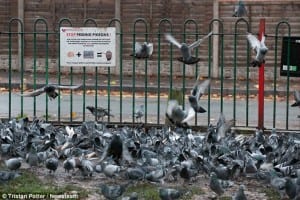
by Pigeon Patrol | Mar 4, 2020 | 4-S Gel Bird repellent, Animal Deterrent Products, Bird Deterrent Products, Bird Netting, Bird Spike, Bird Spikes, Pigeon Control, Pigeon Droppings, Pigeon Patrol's Services, Pigeon Spikes, Pigeons in the News, UltraSonic Bird Control
University Club to Combat Pigeon Droppings With Netting, MIDTOWN EAST — Bye bye birdies.
The exclusive University Club on Fifth Avenue in midtown got approval from the New York City Landmarks Preservation Commission Tuesday to put up bird netting to control pigeon droppings.
Pesky pigeons were leaving droppings along the facade of the Beaux-Arts building and the netting is designed to prevent the birds from nesting on window ledges. The club will put up the netting between its main building and an annex along E. 54th Street.
The club, which counts Mayor Michael Bloomberg and Gov. David Paterson among its members, resides in a landmark building and needed commission approval to kick out the critters.
“It doesn’t detract from the architectural integrity of the building,” said Lisi de Bourbon, spokesperson for the Landmarks Preservation Commission.
The affected area has a service entrance and serves as a light shaft, making the netting barely visible to other buildings, according to de Bourbon.
Source
At Pigeon Patrol, we manufacture and offer a variety of bird deterrents, ranging from Ultra-flex Bird Spikes with UV protection, Bird Netting, 4-S Gel and the best Ultrasonic and audible sound devices on the market today.
Contact us at 1- 877– 4– NO-BIRD, (604) 585-9279 or visit our website at www.pigeonpatrol.ca
Bird Gone, Pigeon Gone, Seagull Gone, Pigeon issue, pigeon spikes, 1-877-4NO-BIRD, 4-S Gel, Bird Control, Pigeon Control, bird repellent, Bird Spikes, sonic bird repellent, stainless steel bird spikes, bird spikes Vancouver, Ultra Sonic Bird Control, Bird Netting, Plastic Bird Spikes, Canada bird spike deterrents, Pigeon Pests, B Gone Pigeon, Pigeon Patrol, pest controller, pest control operator, pest control technician, Pigeon Control Products, humane pigeon spikes, pigeon deterrents, pigeon traps, Pigeon repellents, Sound & Laser Deterrents, wildlife control, raccoon, skunk, squirrel deterrent, De-Fence Spikes, Dragons Den, Canada bird spikes, Canada pigeon, pigeon control, pigeon patrol, pigeon. Kill pigeons, crow, starling
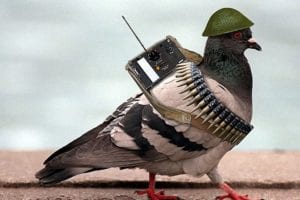
by Pigeon Patrol | Mar 4, 2020 | 4-S Gel Bird repellent, Animal Deterrent Products, Bird Deterrent Products, Bird Netting, Bird Spike, Bird Spikes, Pigeon Control, Pigeon Droppings, Pigeon Patrol's Services, Pigeon Spikes, Pigeons in the News, UltraSonic Bird Control
Fights of fancy: MI5’s post-war plan to use remote-controlled homing pigeons

It would most likely be dismissed as a bird-brained idea nowadays.
But a former spy chief’s diaries have revealed he seriously considered using radio-controlled homing pigeons with experts after the Second World War.
Guy Liddell, then deputy director general of MI5, wrote on October 3, 1946, how he had a meeting with Captain James Caiger, who ran the Army’s pigeon loft.
He wrote: “He is our pigeon expert. He talks, thinks and dreams about them.
“He has had pigeons since he was a boy and his father had pigeons before him.
“I asked him about the homing instinct. He said the matter is quite unsolved.
“There is however, one curious fact, namely that in a sun spot year, all pigeons go haywire.
“Sun spots are, of course, minute radio-active particles – though how they affect the pigeons’ homing instinct nobody knows.
“This gives some colour to the suggestion that pigeons might be able to home on an electric beam, in other words that you might have radio-controlled pigeons.”
Previously released MI5 files have referred to plans to train pigeons to carry explosives to fly into enemy searchlights.
Mr Liddell’s diaries, just released to the National Archives in Kew, West London, also refer to a meeting with colleagues in 1949 to discuss impregnating papers with radioactive substances to set off an alarm if they were taken from a building.
He wrote that he was told, “It is quite possible to impregnate paper, metal clips or ink with a radioactive substance and to install either under the floor boards or in a door post, or under the ground outside an apparatus which will register if anybody goes out of the building with a secret paper so impregnated”.
He wrote there would also be a minor health risk if someone left the papers lying around.
“It would at the outset produce extreme lassitude and later a loss of blood counts,” he said.
“No serious harm would result if the papers were removed and the symptoms detected.”
Source
At Pigeon Patrol, we manufacture and offer a variety of bird deterrents, ranging from Ultra-flex Bird Spikes with UV protection, Bird Netting, 4-S Gel and the best Ultrasonic and audible sound devices on the market today.
Contact us at 1- 877– 4– NO-BIRD, (604) 585-9279 or visit our website at www.pigeonpatrol.ca
Bird Gone, Pigeon Gone, Seagull Gone, Pigeon issue, pigeon spikes, 1-877-4NO-BIRD, 4-S Gel, Bird Control, Pigeon Control, bird repellent, Bird Spikes, sonic bird repellent, stainless steel bird spikes, bird spikes Vancouver, Ultra Sonic Bird Control, Bird Netting, Plastic Bird Spikes, Canada bird spike deterrents, Pigeon Pests, B Gone Pigeon, Pigeon Patrol, pest controller, pest control operator, pest control technician, Pigeon Control Products, humane pigeon spikes, pigeon deterrents, pigeon traps, Pigeon repellents, Sound & Laser Deterrents, wildlife control, raccoon, skunk, squirrel deterrent, De-Fence Spikes, Dragons Den, Canada bird spikes, Canada pigeon, pigeon control, pigeon patrol, pigeon. Kill pigeons, crow, starling

by Pigeon Patrol | Mar 4, 2020 | 4-S Gel Bird repellent, Animal Deterrent Products, Bird Deterrent Products, Bird Netting, Bird Spike, Bird Spikes, Pigeon Control, Pigeon Droppings, Pigeon Patrol's Services, Pigeon Spikes, Pigeons in the News, UltraSonic Bird Control
Pigeon racing rules the roost in China among bird sports, with one enthusiast even spending $200,000 to buy a prized pigeon.
Pigeon takes flight in China. The sport of pigeon racing might have first taken off in Western Europe with the Romans in 220AD, however it didn’t find a perch in China until the 1960s in Shanghai. Back then, the main breeds of pigeons used for racing were the native Li and Yang species. China’s reform and opening-up in the late 1970s saw an influx of foreign breeds introduced into the country however, causing the sport to soar.
Big domestic races
Boasting about 30,000 registered members, the Beijing Racing Pigeon Association (BRPA) is preparing to sound its air horn for this year’s first homing pigeon race in Xinxiang, Henan Province, on April 22 takes flight in China. The 550-kilometer race, which involved 20,000 pigeons last year, will this year see feathers fly among pigeons from Beijing’s 14 districts and two counties.
The birds will be transported to the race course via trucks, then taken out from their lofts and released to fly home. With electronic timing, the first pigeon past the post stands to pocket its owner 3,000 yuan ($474.60) and a trophy. The BRPA will also have a flock of competitors in a 1,000-kilometer national race in Hubei Province, as well as another 600-kilometer race in Henan Province, both slated to be held in May.
The BRPA is currently spearheading intensive training for its members ahead of the big races. Pigeon trainers are already familiarizing their birds with the courses. “Usually, we put our pigeons through five or six days of intensive training ahead of a big race,” said Wu Changfu, 56, who trains 50 pigeons and will enter 10 into the Henan race.
“It takes about six hours for the pigeons to fly 500 kilometers.”
Endurance and speed
Bred with an innate homing ability, modern-day homing pigeons have been known to fly up to 1,800 kilometers in a single race at speeds of between 80 to 170 kilometers per hour.
Pigeons usually begin racing at six months old and compete until they are 10 years old. Ding Haichao, a 38-year-old pigeon owner who took up the sport 16 years ago, said some pigeons begin racing at just three months old.
Most racing pigeons are of foreign breeds as they are faster then domestic ones. In an average 500-kilometer race, foreign breeds can finish up to a half hour faster than their Chinese counterparts, said Wu.
It isn’t all glory for pigeon owners though. Training their birds often spans an hour early in the morning and late in the afternoon. While the birds are away, the owner usually busies themselves by disinfecting their birds’ aviary.
“It is important to train pigeons to fly when the weather is not so favorable, such as in rain or snow. This way, they can get good exercise and brace themselves for inclement weather during races,” said Ding, who owns the Beijing Shouxin Homing Pigeon Loft in the capital’s southern Daxing district China and raises about 1,000 pigeons for different owners before the takes flight.
Flippin’ the bird
Although pigeon racing originated in the West, it has flown to new heights in China half a century after it first made its mark. Prize money for pigeon races in China can reach as high as one million yuan, proving the sport is big business among enthusiasts.
In January last year, a Chinese buyer paid $200,000 for a racing pigeon at a Belgium auction, setting a new world record. The bird’s name was Blue Prince, and he was one of the highly pedigreed racing pigeons that have long been considered the gold standard in the pigeon racing world.
While there are concerns among pigeon racing purists in Europe that the sport faces decline amid the continent’s debt crisis and aging of bird owners, more young people in China are taking an interest in the sport, ensuring its future remains bright.
Passion for competition coupled with lucrative prize money offered in races suggests pigeon owners in China are in it for the long haul, and aren’t merely winging it.
Source
At Pigeon Patrol, we manufacture and offer a variety of bird deterrents, ranging from Ultra-flex Bird Spikes with UV protection, Bird Netting, 4-S Gel and the best Ultrasonic and audible sound devices on the market today.
Contact us at 1- 877– 4– NO-BIRD, (604) 585-9279 or visit our website at www.pigeonpatrol.ca
Bird Gone, Pigeon Gone, Seagull Gone, Pigeon issue, pigeon spikes, 1-877-4NO-BIRD, 4-S Gel, Bird Control, Pigeon Control, bird repellent, Bird Spikes, sonic bird repellent, stainless steel bird spikes, bird spikes Vancouver, Ultra Sonic Bird Control, Bird Netting, Plastic Bird Spikes, Canada bird spike deterrents, Pigeon Pests, B Gone Pigeon, Pigeon Patrol, pest controller, pest control operator, pest control technician, Pigeon Control Products, humane pigeon spikes, pigeon deterrents, pigeon traps, Pigeon repellents, Sound & Laser Deterrents, wildlife control, raccoon, skunk, squirrel deterrent, De-Fence Spikes, Dragons Den, Canada bird spikes, Canada pigeon, pigeon control, pigeon patrol, pigeon. Kill pigeons, crow, starling







